Conservation Science
Protecting Pennsylvania’s Plants and Animals
Indicator Species
What do carnivorous pitcher plants, elusive hellbenders, singing woodthrush and humming mayflies have in common? They’re all important species known as indicators. An indicator species is any species (plant, animal, bird, insect or even bacteria) that reflects the condition of its environment. Indicator species are often the first in their ecosystem to be affected by environmental change.
The presence of indicator species can signify many things, including type or quality of habitat, health of an ecosystem or even land conservation value, just to name a few.
Some indicator species occur commonly. For example, turkey and white-tailed deer indicate early successional habitat, woodthrush can indicate interior forest habitat, and mayflies can indicate good water quality on a stream. Other indicators are rare, such as freshwater mussels, which, like mayflies and other aquatic macroinvertebrates, indicate good water quality. The plant species found at a site reflect the site’s environmental conditions and degree of human disturbance, also called “ecological integrity.”
The following is a small selection of indicator species found in Western Pennsylvania. Discover what they indicate, how these species inform the Conservancy’s work, and their conservation status in the 2015-2025 Pennsylvania Wildlife Action Plan.
NATIVE SPECIES
Native Brook Trout (Salvelinus fontinalis)
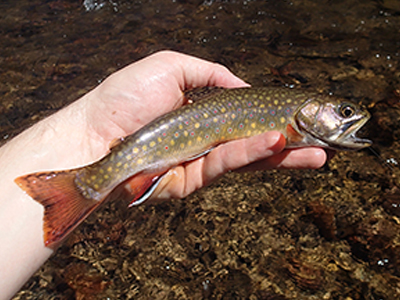
Pennsylvania’s state fish, brook trout grow 9 to 12 inches long with a body that’s wide in the middle and tapers at each end. Its olive green back has pale, worm-like markings, and its sides are tinged blue with yellow and red spots.
Indicates: High-quality cold-water stream, because reproducing brook trout require cold, exceptionally clean water
Found In: Mountain (high gradient) streams and rivers, especially those with riffles and shade
Conservancy watershed scientists can note the presence of brook trout as an indicator of a successful project. For example, if a dam or culvert is removed to improve aquatic organism passage, the presence of breeding trout in the stream indicates that the project was successful because the trout can now move freely upstream to breed in a larger gene pool. We locate populations through our partnership in the Unassessed Waters Program with Pennsylvania Fish and Boat Commission, and improve habitat improvements through in-stream and riparian restoration.
Species of Greatest Conservation Need
Upland, or Orange, Burrowing Crayfish (Cambarus dubius)
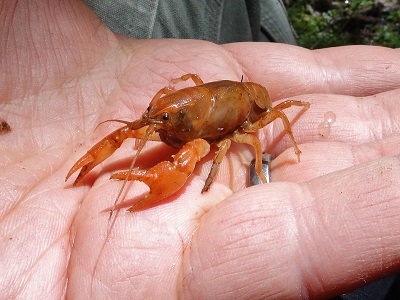
This is not the only upland burrowing crayfish species, so some of our ecologists call these the Orange Burrowing Crayfish, because no other Pennsylvania species are orange like this. Rarely seen on the surface, they emerge at night or during rain, when the air is very humid, and forage for leaves and small animals. They especially like worms. They often sit at the mouth of their burrow at night, waiting for prey to wander past. The mothers provide extended parental care, sharing burrows with offspring, providing food and protection.
Indicates: Clay and silty soils; generally found in or near wetlands
Found In: Where the groundwater is close to the surface (not necessarily near surface water). They burrow into the groundwater, leaving chimneys, or piles of mud pellets, or blops of mud on the surface, depending on the moisture and clay content of the soil. They are somewhat tolerant of disturbance (For example, can sometimes be found in roadside ditches.) and need clean groundwater.
Their range is limited to Fayette and Somerset counties, including Bear Run Nature Reserve, and parts of adjacent West Virginia. The range also includes one county in Maryland, and there is one record in Westmoreland County.
"Vulnerable" in Pennsylvania. In the 2025 State Wildlife Action Plan it will be recognized as a Pennsylvania Responsibility Species, meaning that PA has a large portion of the species' range or population.
Pennsylvania Crayfish Fauna Finally Getting Some Attention (p. 4)
Freshwater mussels (67 species in Pennsylvania)
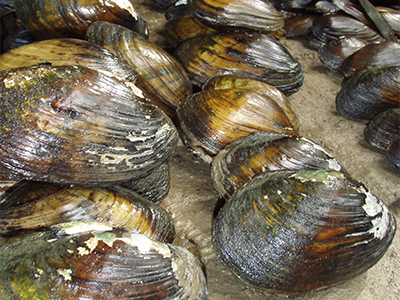
Freshwater mussels have unconventional names such as snuffbox and wartyback, and can be mistaken for stones on a creek’s sandy bottom. But these hard-shelled, long-lived bivalve mollusks (also known as nature’s filters, lungs of the water and workhorses of the water) remove silt and reduce pollutants, filtering up to 15 gallons of fresh water daily.
Indicates: Long-term stream health and good aquatic habitat
Found in: Variety of aquatic ecosystems including streams, rivers and lakes
Watershed conservation and PNHP teams conduct freshwater mussel surveys and have introduced juvenile mussels to streams to assess which streams are candidates for restocking freshwater mussels.
Of PA’s 67 freshwater mussel species, 12 are state or federally endangered or threatened and another 13 have not been observed in PA waterways for decades. The U.S. Fish and Wildlife Service has proposed salamander mussels be listed as endangered.
Eastern Hellbender (Cryptobranchus alleganiensis alleganiensis)
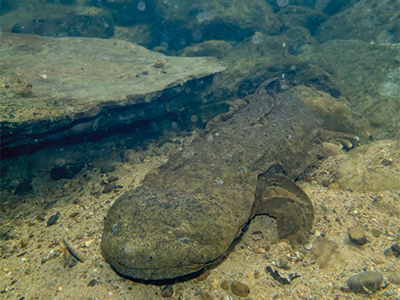
The eastern hellbender, Pennsylvania's state amphibian and North America's largest salamander, can weigh more than four pounds and grow as long as two feet. These reclusive nocturnal creatures live almost exclusively under large cover objects, such as flat rocks the size of a kitchen table.
Indicates: Long-term ecosystem health
Found in: Streams and rivers with good flow, and large substrate for nest rock locations
Watershed conservation staff has studied the species since 2007 to document as many populations as possible. They use a variety of techniques to find this elusive animal, including: lift and turn surveys, SCUBA surveys and eDNA (environmental deoxyribonucleic acid).
Species of Concern
Scarlett Tanager, Wood Thrush, Evening Grosbeak and Other Forest-interior Birds
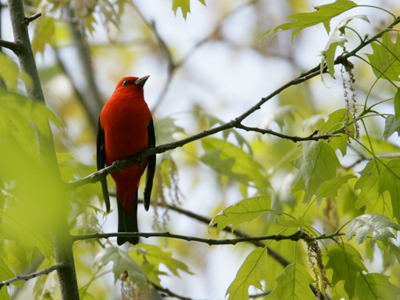
Forest-interior birds, including scarlet tanagers and evening grosbeaks, are a particular group of forest birds that require large, mature forests to maintain populations. A variety of species rely on these habitats, including warblers, thrushes, vireos, flycatchers and tanagers. Of the nearly 110 species of forest-dependent breeding birds in Pennsylvania, approximately 40 require interior forest to maintain healthy populations.
Indicates: High quality habitat especially with the presence of other forest interior birds
Found in: Mature interior forests
PNHP: Our Evening Grosbeak conservation Project to join the Road to Recovery Initiative as one of their pilot projects for On-Alert and Tipping Point Species in need of strong and immediate action to pinpoint causes of declines and to support efforts to recovering their populations.
Scarlet tanager is Species of Greatest Conservation Need; Evening grosbeak is at risk; other species vary.
Since 1970 we have lost nearly 3 billion birds across North America – almost a 30% population decline across all bird species.
Birds face unprecedented, widespread threats including habitat loss. Forest birds in particular thrive best in large tracts of contiguous forest, making them very vulnerable to the impacts of fragmentation.
Frosted Elfin Butterfly (Callophrys irus)
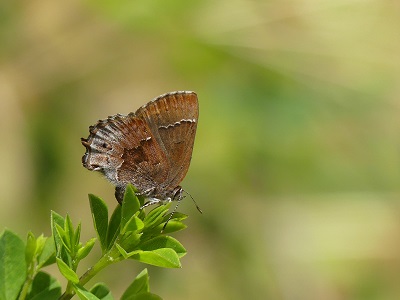
The frosted elfin is a small brownish-gray butterfly with tiny tails and silvery scales on the hindwings that give it a frosted appearance. The relationship between a frosted elfin butterfly and its host plants, wild indigo and wild lupine, is an excellent example of how a host plant indicates a habitat for a specific pollinator. It is important to know how to make the habitat more suitable for the host plant, which is better for the butterfly. If the plant is not there, the butterfly won’t be there.
Indicates: Barrens and open, dry habitats that support their host species
Found in: Pine barrens, a rare habitat type characterized by fire-dependent conifers, scrub oak and grassy openings that support wild indigo and wild blue lupine
PNHP scientists investigate the distribution and extent of the butterflies and their caterpillar food plants in PA, evaluate the condition of their habitats, and identify potential population stressors such as habitat succession, development, invasive plants, deer herbivory, and incompatible vegetation management. This survey information aids in evaluating the status of the butterflies in Pennsylvania, and helps us protect and manage their remaining populations.
Critically imperiled. Habitat loss has caused a scarcity of host plants, which the butterflies need to lay eggs and feed.
Pitcher Plants (Sarracenia purpurea)
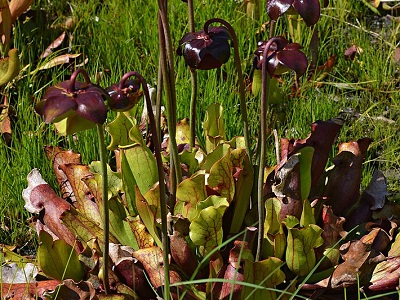
These carnivorous Pennsylvania native plants, found in bogs and mossy swamps, have leaves shaped like pitchers or tubes, edged with a nectar to attract insects. Insects land on the edge of the tube and fall into the trap, where hairs inside prevent escape. The insect is digested by enzymes in the plant.
Indicates: High quality habitats. Peatlands and bogs, where pitcher plants grow, regulate streamflow and groundwater recharge, protecting water quality. Home to many rare plants, bird and insects, they store large amounts of carbon, which mitigate the effects of climate change.
Found in: Sphagnum bogs and other acidic wetlands
PNHP has been characterizing and sampling peatlands across the state to better understand these systems, add to the natural community classification of Pennsylvania and set up monitoring to evaluate the impacts of climate change over time.
Apparently secure; common
Fairy Shrimp (Eubranchipus ssp)

Growing to half inch to two inches long, fairy shrimp have 11 pairs of leg-like appendages called phyllopods used for swimming belly-side up. Wood frogs and salamanders such as spotted, Jefferson and marbled, are all vernal pool indicators, as are the delicate fairy shrimp.
Various insects, crustaceans, amphibians and other invertebrates that need water early in their lifecycles live in vernal pools, free from predation from fish, which could not survive in vernal pool conditions. Vernal pool species can survive low oxygen levels and drying out completely in summer, and fare well in stagnant water – all conditions that fish cannot tolerate.
Indicates: Vernal pool habitat
Found in: Vernal pools, which are shallow depressions on land, usually surrounded by trees, that temporarily fill with snow melt and rainwater and only appear in the spring and fall.
Heritage Program scientists have been working with partners from PA DCNR State Parks and PA Fish and Boat Commission to catalogue, map, describe and restore vernal pools across Pennsylvania.
Fairy shrimp are a primary source of food for many species of amphibians found in vernal pools.
No PA status; secure
INVASIVE SPECIES
Invasive species can also be indicator species. For example, their presence can indicate invaded habitat that is ecologically degraded. They can be evidence of increased human-caused disturbance.
Areas where these species invade likely were once pristine in their native species diversity and ecological functioning. However, introducing these and other invasive species, whether accidentally or purposefully, can cause rapid and often negative change. In some cases, invasive species can “blend in” with their surroundings, going unnoticed by passersby who might not know their true identity.
Education and awareness--coupled with vigilant searching--can allow natural resource professionals and community scientists to better understand invasive species distributions and inform land managers of areas where treatment should be prioritized.
Japanese Barberry (Berberis thunbergii)
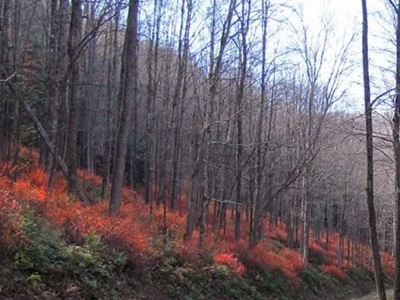
An ornamental shrub historically used in living fences for livestock and for herbal medicine, the invasive Japanese barberry was imported into the United States in 1875.
Japanese barberry has oval-shaped leaves that are often red-tinged. Compact and dense, it rarely exceeds four feet in height. Interestingly, it will root where its drooping branches touch the ground, a process called layering. In mid-spring to early summer, drooping clusters of pale yellow flowers develop, turning into bright red berries.
Indicates: Large patches or monocultures of Japanese barberry can indicate an invaded habitat that has been ecologically degraded. Its presence in natural areas can harm spring-time tourism due to its ability to displace and outcompete spring ephemeral wildflowers that many people will travel far to observe in bloom.
The presence of Japanese barberry in natural areas warrants management, which can come with high economic costs in terms of manpower, time, equipment and herbicide. Effective control efforts can prevent Japanese barberry from altering important ecosystems and displacing native plants that are important to pollinators.
Found In: Barberry is shade tolerant, drought resistant and adaptable to a variety of wooded habitats, wetlands and disturbed areas. Due to its popularity in the nursery trade, Japanese barberry can often be found growing in residential and commercial areas.
Some information sourced from the DCNR fact sheet for Japanese and European Barberry and Penn State Extension’s Japanese Barberry factsheet.
WPC and Pennsylvania Natural Heritage Program conduct invasive species surveys in natural areas across western Pennsylvania and other parts of the state. Findings of Japanese barberry are among the species being observed and documented by science staff.
Staff and volunteers have removed patches of Japanese barberry on WPC preserves, including Bear Run Nature Reserve.
Additionally, WPC and PNHP administer the Pennsylvania iMapInvasives Program, a publicly-accessible online tool used for reporting invasive species occurrences and management efforts across the Commonwealth. Natural resource professionals and community scientists are encouraged to report their findings of Japanese barberry to iMapInvasives by signing up for a free account or completing a public report.
Pennsylvania Class B Noxious Weed (view full list).
As a noxious weed, Japanese barberry may no longer be distributed, cultivated or propagated within the Commonwealth, except for approved exempted varieties. More information is available from the PA Department of Agriculture.
Factsheets produced by Pennsylvania DCNR and Penn State Extension
Learn more about identifying Japanese barberry, the ecological threat it presents, and options for controlling it on our webpage, Japanese Barberry.
Lesser Celandine (Ficaria verna)
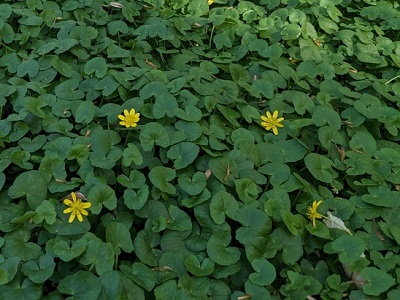
The bright yellow flowers of lesser celandine bloom in early spring, rising above their green, kidney-shaped leaves. Abundant, finger-like tubers are produced by the plant's roots and are only visible if dug out of the ground. This aggressive perennial plant emerges earlier than most native species and can easily displace native spring ephemerals with its thick carpet of vegetation. This in turn negatively affects native pollinators, which rely on spring ephemerals for nectar and pollen during a time when other food sources are scarce.
Indicates: Monocultures of lesser celandine indicate an invaded habitat that has been ecologically degraded. Its presence in natural areas can harm spring-time eco-tourism from lesser celandine’s ability to displace and outcompete spring ephemeral wildflowers that many people will travel far to observe in bloom.
The presence of lesser celandine in natural areas warrants management, which can come with high economic costs in terms of manpower, time, equipment and herbicide. Effective control efforts can prevent lesser celandine from altering important ecosystems and displacing native plants that are important to pollinators.
Found In: Forested floodplains, woods, meadows, roadsides and waste places. Lesser celandine seems to prefer moist, sandy soils. Less frequently, it will invade drier soils.
Some information sourced from the DCNR fact sheet for Lesser celandine.
The Western Pennsylvania Conservancy and Pennsylvania Natural Heritage Program conduct surveys in the Lake Erie Watershed where lesser celandine is mostly restricted to the urban areas and has not yet spread to most major tributaries.
Additionally, the WPC and PNHP administer the Pennsylvania iMapInvasives Program, a publicly-accessible online tool used for reporting invasive species occurrences and management efforts across the Commonwealth. Natural resource professionals and community scientists are encouraged to report their findings of lesser celandine to iMapInvasives by signing up for a free account or completing a public report.
Pennsylvania Class B Noxious Weed (see full list of PA noxious weeds)
Hydrilla (Hydrilla verticillata)
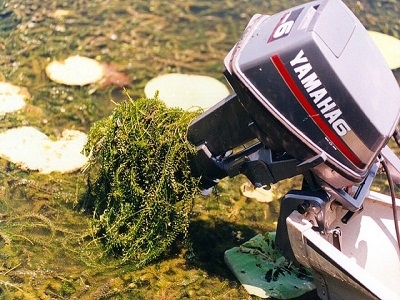
Hydrilla, a submerged aquatic plant, can grow in water as deep as 20 to 40 feet. Its green leaves are whorled in bunches of 3 to 8 (most often five) and its stems are long and branching. Its leaves have small sharp teeth on the edges and sometimes have spines on the midvein, which make the plant feel rough to the touch. During the late growing season, small white tubers form on the plant roots. They are used for food storage and allow the plant to over-winter.
Indicates: Monocultures of hydrilla indicate an invaded habitat that is has been ecologically degraded. Its presence in both large and small waterbodies can hinder biodiversity and limit aquatic recreation including fishing, swimming and boating. Propeller boats can easily become clogged by hydrilla’s thick floating mats, requiring frequent cleanings to travel short distances.
The presence of hydrilla in natural areas warrants management, which can come with high economic costs in terms of manpower, time, equipment, and herbicide. Effective control efforts such as those occurring at Pymatuning Reservoir (Crawford County), Raystown Lake (Huntingdon County) and Harvey’s Lake (Luzerne County) can prevent hydrilla from altering important ecosystems and displacing native species.
*Note: Management efforts occurring at the aforementioned locations are being led by various state agencies and organizations.
Found In: Freshwater lakes, ponds, rivers, impoundments and canals.
Some information sourced from PA DCNR and PA Sea Grant.
WPC and Pennsylvania Natural Heritage Program conduct surveys in the Lake Erie watershed where hydrilla has been found in several privately owned ponds. Treatment efforts by WPC, PNHP and partners has been done with the goal of preventing hydrilla’s spread to Lake Erie.
Additionally, the WPC and PNHP administer the Pennsylvania iMapInvasives Program, a publicly-accessible online tool used for reporting invasive species occurrences and management efforts across the Commonwealth. Natural resource professionals and community scientists are encouraged to report their findings of hydrilla to iMapInvasives by signing up for a free account or completing a public report.
Federal noxious weed (view full list); Pennsylvania Class A Noxious Weed (view full list)
Factsheets produced by Pennsylvania DCNR and Pennsylvania Sea Grant
Learn more about the threats posed by aquatic invasive species by watching the documentary film, “Seeing The Unseen: Aquatic Invaders & What’s at Stake”, executively produced by WPC staff.
For More Information:
Western Pennsylvania Conservancy
Natural Heritage Program
800 Waterfront Drive
Pittsburgh, PA 15222
412-586-2392
Pennsylvania Natural Heritage Program
Rachel Carson State Office Building
5th Floor
400 Market Street
Harrisburg, PA 17105
